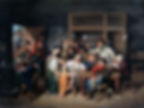Last week’s post focused on taverns as centers as news. This week’s post continues the theme of communication by talking about taverns as post offices.
The painting chosen for this week’s #TavernTales is John Lewis Krimmel’s Village Tavern from 1813-1814.
Just like last week, there is a man reading a newspaper at the center table and another one at the woodstove doing the same. You can also see more newspapers hanging behind the outside door. The bar’s various drinking containers hint at the types of alcohol being served (beer, punch, wine, etc.). And the almanac hanging on the bar door tells us the year is 1814. (Bonus points if you can find Krimmel’s initials.)
The guy coming in from the outside has a large mail pouch draped over his right shoulder and is also carrying a basket with parcels in it. The man in red next to him is very likely announcing to the crowd that the mail has arrived.
Taverns as post offices, or at least central places where mail would be delivered, go back to English customs where the mail would often be dropped off at taverns. And then the tavern keeper would somehow let the recipient know that their mail was at the tavern. Here in the Chesapeake you can find notices in both the Virginia Gazette and Maryland Gazette where tavern keepers are posting a list of people that can come pick up their mail. When the recipient went to the tavern to get their mail, they were expected to pay the tavern keeper a small fee to help offset the cost of taking out a newspaper advertisement.
The first official post office in the North American English colonies was started in 1639 in Boston at Richard Fairbanks tavern. The official government record from reads in part:
“For preventing the miscarriage of letters; & it is ordered, that notice bee given that Richard Fairbanks his house in Boston is the place appointed for all letters which are brought from beyond the seas, or are to be sent thither, are to bee brought into; and hee is to take care that they bee delivered or sent according to their directions; and hee is allowed for every such letter 1 penny, & must answere all miscarriages through his owne neglect in this kind....”
Because the designation as an official post office was a desired thing, many tavern keepers throughout the colonies competed with each other to become the post office for their community. Being designated as the local post office was a mark of distinction for tavern keepers.
The practice of taverns also acting as post offices continued through at least the American Civil War. A local mural in Silver Spring, Maryland shows Union Troops reading their mail at the Eagle Tavern.
Want to learn more Tavern Tales? Come to Drinks with the Director!
On Saturday, July 4 from 12:30 - 2:30pm, executive director Rod Cofield will play bartender, serving up punch and cider while sharing the important role of taverns in the 17th and 18th centuries. Enjoy a relaxed afternoon of drinks and conversation on taverns, archaeology, and early America. Learn more and sign up to participate.
